|
| |
Wildlife Watch at Merrimac Farm
| April 19, 2009 |
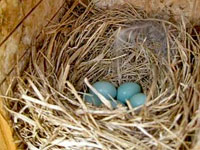 |
Bluebird Trail News from Bill Ryder - 11 total eggs in 4 nests on Sunday! I've included a photo of the eggs in box 6 (left). There are 5 in there. Unfortunately, the sparrows were back in box 4, had to clean out their nest again. If all goes well, there should be little bluebirds all over the place soon. |
|
| |
| April 17, 2009 |
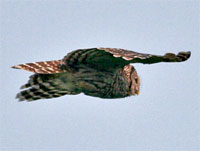 |
A barred owl was sighted in the cedar trees in front of the stone house at Merrimac Farm WMA at 10:30 in the morning. The bird flew out from its cedar tree roost into some hardwoods across the driveway, and then it looked down a couple of times before flying off out of view. This owl probably hunts in the vicinity on a regular basis, as owl feathers were sighted in several places in the yard. Also, two barred owls were later heard calling to each other from the woods behind the stone house, around 2:00 p.m. Barred owls are excellent predators and play an important role in the food web by helping keep small mammal populations in check. |
 |
Red-tailed hawks generally hunt from a perch, scanning the surrounding area for prey before gliding down with legs thrust forward to seize a small mammal, snake or bird. We saw this red-tailed hawk in early afternoon carrying a small rodent back to a feeding perch, where it was devoured whole. Red-tailed hawks also hunt snakes and other birds, which they behead and pluck before eating. Common in Northern Virginia, look for red-tailed hawks in open areas with scattered, elevated perches. |
 |
Eastern Bluebird Trail Update - Two nesting boxes have complete bluebird nests and it looks like there's one more underway. One box holds a Tufted Titmouse nest and unfortunately a pair of House Sparrows were about finished building a nest in one box. These nonnative birds kill Bluebirds and their young, and are a major factor in the decline of Bluebirds and other cavity-nesters in North America. One Bluebird Trail monitor who lives close to the site will be checking this box every day and removing nesting materials in hopes of discouraging the House Sparrows. Photo by Julia Flanagan |
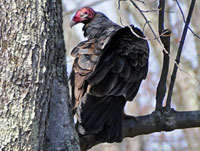 |
Turkey vultures are permanent residents that are often seen gliding over forests and farms. They breed in very early spring, when one or two eggs are laid directly on the ground or leaf litter, in a rock crevice or a hollow tree. Both parents care for the chicks, which are helpless at birth. Generally considered beneficial scavengers, turkey vultures have a highly developed sense of smell and can locate a hidden carcass under a forest canopy. We saw this Turkey Vulture perched in a tree above a dead deer lying alongside the road on our way out of Merrimac Farm. Photo by Kim Hosen |
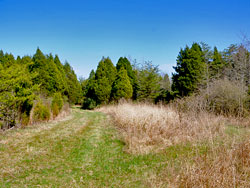 |
This open corridor lies between a woods dominated by cedars and field habitats in the central portion of Merrimac Farm. Edge habitats - areas that provide tree and shrub cover in close proximity to open areas - increase habitat diversity and can be great areas for wildlife watching. Keep you eyes open for birds and butterflies as you walk this section of the Bluebell Trail at Merrimac Farm. Photo by Kim Hosen |
|
| |
April 8, 2009
 News from Wayne Kurtz - Neil and I did our monitoring of the Bluebird boxes today. There is now a complete nest in Box 6, and we found 1 or 2 partial nests in boxes where they were not noted before. We did not see any birds at any of the boxes. News from Wayne Kurtz - Neil and I did our monitoring of the Bluebird boxes today. There is now a complete nest in Box 6, and we found 1 or 2 partial nests in boxes where they were not noted before. We did not see any birds at any of the boxes.
To report on the other wildlife monitoring, I was delighted to see a Red-tailed Hawk flying very low across the road in the woods as I was driving from Box 1 to Box 2. The upper side of the tail was perfectly visible, and was completely refocus red. I never got such a perfect view of the upper side of the tail before.
And then Neil and I both saw a beautiful Red Fox running first along the road behind the tree line, and then crossing the road in front of us, just north of Box 5 on Deepwood Lane.
When we were at the parking lot out from the stone house about 5:15 PM we heard a Barred Owl hooting repeatedly with its characteristic 8 hoots. Earlier on our walk between Box 8 & 9 we thought we heard a dog barking in the direction of Box 5, which in retrospect may have been the Barred Owl. |
|
| |
| April 5, 2009 |
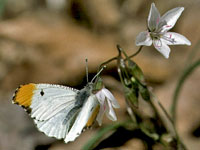 |
We spotted Falcate Orangetip butterflies for the first time at Merrimac Farm today. Considered a harbinger of spring, these small butterflies have only one flight in Northern Virginia, between late March an mi-May. Look for Falcate Orangetips flying close to the ground in open, wet woodland areas. We saw several males patrolling in search of a mate in several locations, including the clearing west of the road to the Stone House and along the road near the pond. These pretty butterflies lay only one egg per host plant, which includes most plants in the mustard family. However, when Falcate Orangetips lay eggs on the exotic, invasive Garlic Mustard, newly hatched caterpillars die after eating the plant. Photo by Patrick Colin. |
 |
Eastern Bluebird Trail Update - Two nesting boxes have complete bluebird nests and it looks like there's one more underway. One box holds a Tufted Titmouse nest and unfortunately a pair of House Sparrows were about finished building a nest in one box. These nonnative birds kill Bluebirds and their young, and are a major factor in the decline of Bluebirds and other cavity-nesters in North America. One Bluebird Trail monitor who lives close to the site will be checking this box every day and removing nesting materials in hopes of discouraging the House Sparrows. Photo by Julia Flanagan |
 |
Turkey vultures are permanent residents that are often seen gliding over forests and farms. They breed in very early spring, when one or two eggs are laid directly on the ground or leaf litter, in a rock crevice or a hollow tree. Both parents care for the chicks, which are helpless at birth. Generally considered beneficial scavengers, turkey vultures have a highly developed sense of smell and can locate a hidden carcass under a forest canopy. We saw this Turkey Vulture perched in a tree above a dead deer lying alongside the road on our way out of Merrimac Farm. Photo by Kim Hosen |
 |
This open corridor lies between a woods dominated by cedars and field habitats in the central portion of Merrimac Farm. Edge habitats - areas that provide tree and shrub cover in close proximity to open areas - increase habitat diversity and can be great areas for wildlife watching. Keep you eyes open for birds and butterflies as you walk this section of the Bluebell Trail at Merrimac Farm. Photo by Kim Hosen |
|
|
|
|
|
|
![]()